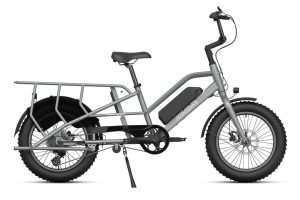How Does Pedal-Assist Mode Work on an E-Bike?
E-Bike
Pedal-assist systems divide the work required to move the bike between the cyclist and the motor. This system provides a more intuitive experience for the rider. Pedal-assist mode offers a variety of settings for varying levels of power delivery. Riders can choose to customize their pedal-assist experience based on their preferred riding style and terrain.
https://www.jobobike.eu/jobobike-world/blog/e-bike-tech/how-e-bikes-work.html
Depending on the model, an e-bike can either help make your pedaling effort easier, or it can simply take over and power the motor without you even needing to pedal. Pedal-assist mode is a great option for those who want to get more exercise and enjoy the cycling experience while still getting some extra oomph from the bike.

Pedal-assist mode functions by using a sensor to detect the force you apply to the pedals. This information is then sent to the controller, which activates the electric motor and provides power assistance based on your pedaling. This type of system is more advanced than cadence sensors and allows the electric motor to provide a progressive level of power.
How Does Pedal-Assist Mode Work on an E-Bike?
This is a much more natural and intuitive way to ride an e-bike. It also tends to have a longer battery life than throttle modes. In addition, most pedal-assist e-bikes feature multiple levels of pedal-assist, so you can choose how strong you want the motor to be.
Pedal-assist mode works by only activating motor power when the rider is pedaling (Class 1 and 2 Ebikes, learn more about the ebike classes here). Compared to throttle modes, this provides a more intuitive feel. Moreover, it helps you to ride longer distances and climb hills without getting tired or sore as easily. Many e-bikes come with multiple pedal-assist settings, from low to high power. You can choose which setting is best suited for the current conditions and your riding mood. You can also control the amount of assistance using the bike’s display controls.
Some e-bikes use cadence sensors, which detect the number of rotations per minute and provide an automatically adjusted level of power. Others use torque sensors, which monitor the force that is pushed on the pedals and adjust the power accordingly. The torque sensor is more advanced than the cadence sensor and offers a more natural and responsive feel. However, it requires more maintenance than a cadence sensor.
Pedal-assist sensors measure your effort to control the motor’s power output. Typically, e-bikes with pedal-assist modes have one of two types of sensors: cadence and torque. Each works differently and provides different ride experiences. Cadence sensors work more or less like an on/off switch, activating the motor when you start pedaling and turning it off when you stop. They require less complexity from the bike’s controller and are generally cheaper to implement. But they also feel less responsive and can cause your e-bike to “jerk” when accelerating or changing speed.
Torque sensors use a precision strain gauge to monitor how hard you are pushing down on the peddles, sampling 1,000 times per second over the entire pedal stroke. This allows the motor to respond more quickly to changes in power, giving you proportional pedaling assistance based on how hard you are pedaling. This makes for a more natural, intuitive, and enjoyable cycling experience than e-bikes that use cadence sensors.